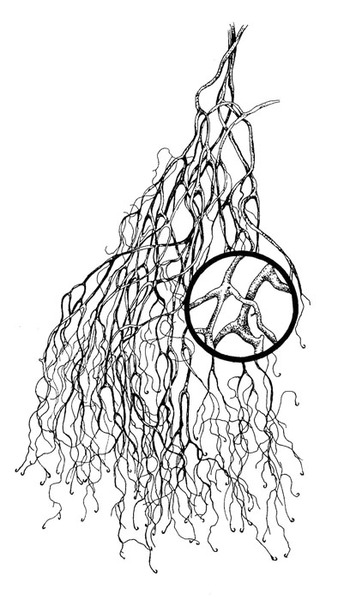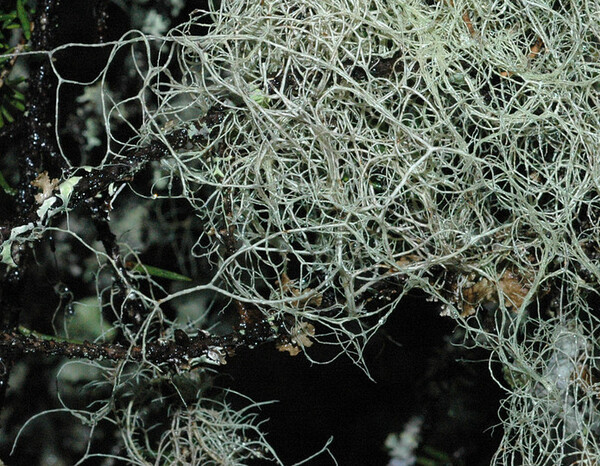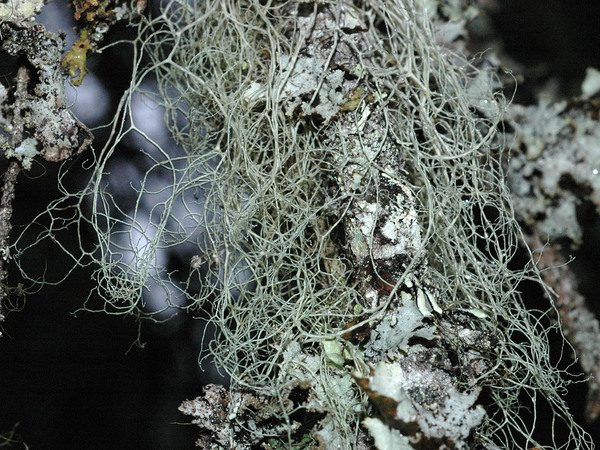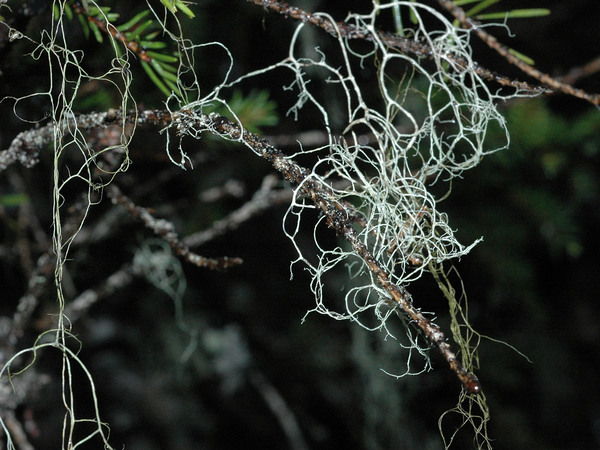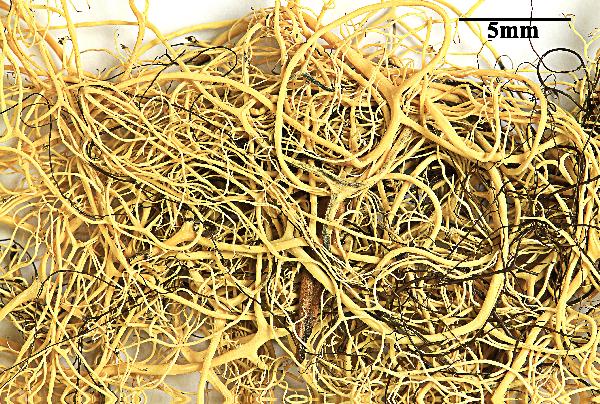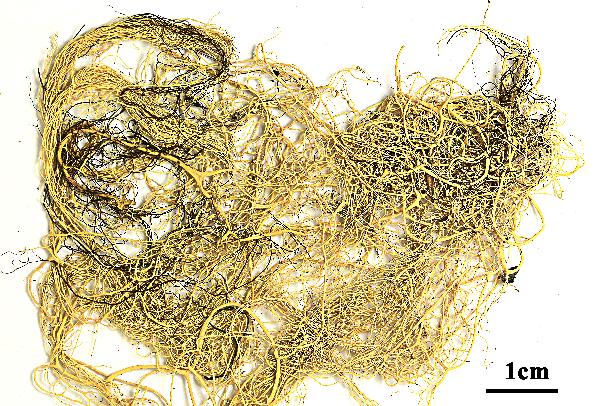Ramalina thrausta (Ach.) Nyl.
Syn. Lich., 1: 296, 1860. Basionym: Alectoria thrausta Ach. - Lichenogr. Univ.: 596, 1810.
Synonyms: Alectoria crinalis Ach.; Alectoria sarmentosa var. crinalis (Ach.) H. Olivier; Ramalina crinalis (Ach.) Gyeln.; Ramalina thrausta f. sorediosula Nyl.
Distribution: N - Frl (Nascimbene & al. 1998), Ven (Nascimbene & Caniglia 2000b, 2003c, Nascimbene 2003b, 2011, Nascimbene & al. 2009c, Ravera & al. 2022), TAA (Nascimbene 2006b, 2008c, 2014, Nascimbene & al. 2006e, 2007b, 2009, 2010, 2014, 2022, Nascimbene & Marini 2015, Nimis & al. 2015, Trindade & al. 2021, Pistocchi & al. 2024), VA (GDOR 1311). C - Tosc (Benesperi & al. 2007), Sar. S - Pugl (Nimis & Tretiach 1999), Si.
Description: Thallus fruticose, filamentous, long-pendent, up to 40 cm long, pale green. Branches thread-like, mostly <0.5(-1) mm in diam. Main branches interwoven, terete, widely divergent or nearly contiguous, the apical branches very thin, the tips often hooked or curled, ending in a minute punctiform soralium with a few granulose soredia; pseudocyphellae punctiform to slightly elongated, slightly raised. Cortex smooth, even, glossy, pale green, rarely with a few minute, oval pseudocyphellae; medulla white, loose, arachnoid. Apothecia never observed in Italian material. Photobiont chlorococcoid. Spot tests: K-, C-, KC- or KC+ pale yellow (cortex only), P-, UV-. Chemistry: cortex with usnic acid, medulla without lichen substances, or with an unknown substance reacting R-.Note: a cool-temperate to southern boreal lichen found on branches and twigs of conifers and deciduous trees in montane forests with frequent fog, occasionally lignicolous and saxicolous; rare and probably declining throughout Italy.
Growth form: Fruticose
Substrata: bark
Photobiont: green algae other than Trentepohlia
Reproductive strategy: mainly asexual, by soredia, or soredia-like structures (e.g. blastidia)
Most common in areas with a humid-warm climate (e.g. most of Tyrrenian Italy)
Commonnes-rarity: (info)
Alpine belt: absent
Subalpine belt: extremely rare
Oromediterranean belt: absent
Montane belt: very rare
Submediterranean belt: absent
Padanian area: absent
Humid submediterranean belt: absent
Humid mediterranean belt: absent
Dry mediterranean belt: absent
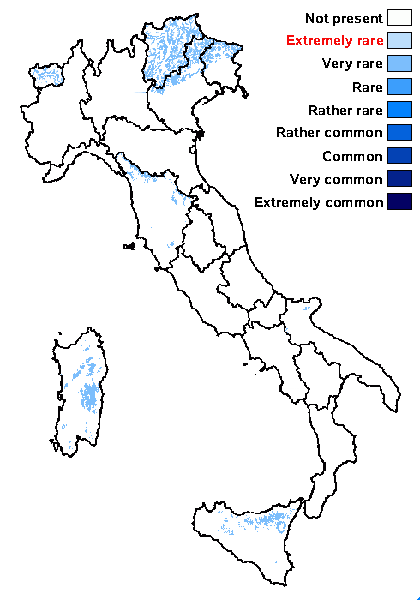
Predictive model
Herbarium samples
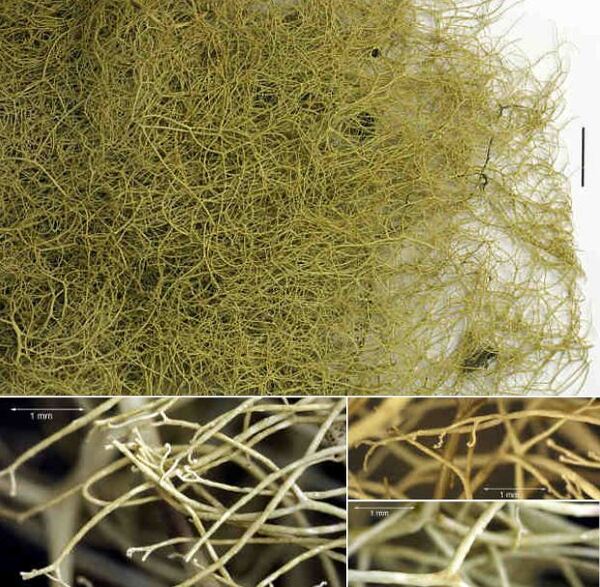

Felix Schumm – CC BY-SA 4.0
Image from: F. Schumm (2008) - Flechten Madeiras, der Kanaren und Azoren. Beck, OHG - ISBN: 978-3-00-023700-3


P.L. Nimis; Owner: Department of Life Sciences, University of Trieste
Herbarium: TSB (3692)
2001/12/07
hook-shaped soralium
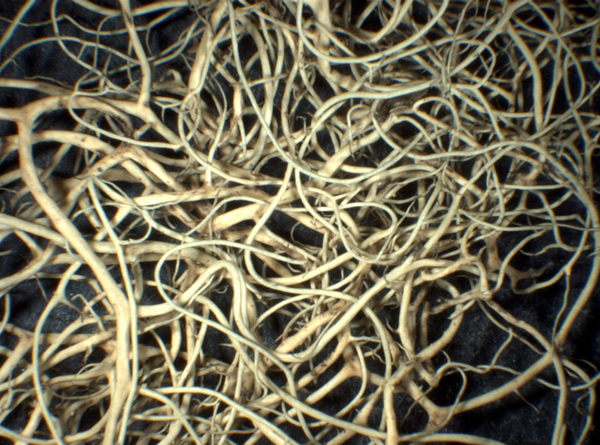

P.L.Nimis; Owner: Department of Life Sciences, University of Trieste
Herbarium: TSB (36787)
2008.02.25

Felix Schumm - CC BY-SA 4.0
[9141], Spanien, Kanarische Inseln, La Gomera, Chorros de Epina, zwischen Arure und Vallehermoso. Im Lorbeer-Erica Wald, 28°09.830' N, 17°17.852 W, 750-850 m. Leg et det. F. Schumm 10.02.2002
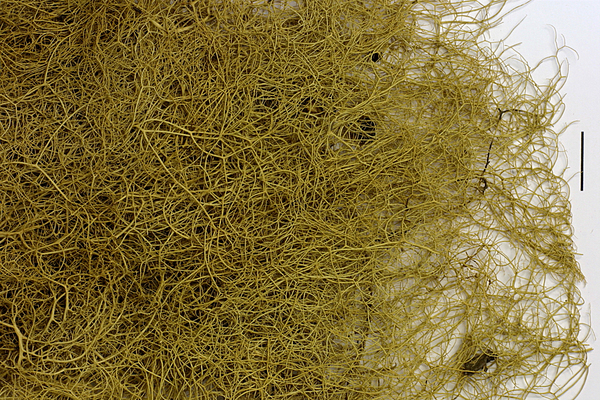
Felix Schumm - CC BY-SA 4.0
[9141], Spanien, Kanarische Inseln, La Gomera, Chorros de Epina, zwischen Arure und Vallehermoso. Im Lorbeer-Erica Wald, 28°09.830' N, 17°17.852 W, 750-850 m. Leg et det. F. Schumm 10.02.2002
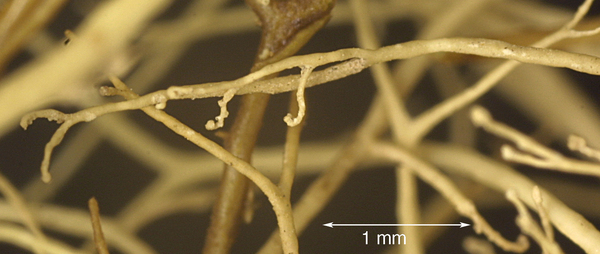
Felix Schumm - CC BY-SA 4.0
[9141], Spanien, Kanarische Inseln, La Gomera, Chorros de Epina, zwischen Arure und Vallehermoso. Im Lorbeer-Erica Wald, 28°09.830' N, 17°17.852 W, 750-850 m. Leg et det. F. Schumm 10.02.2002
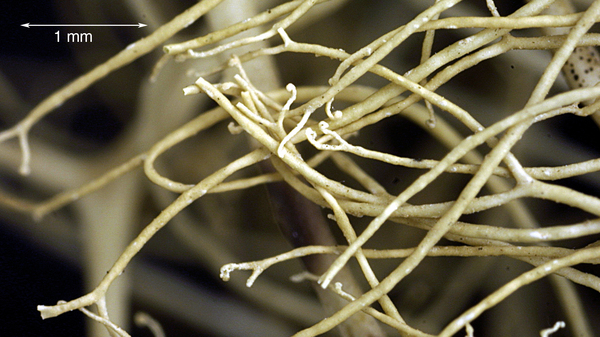
Felix Schumm - CC BY-SA 4.0
[9141], Spanien, Kanarische Inseln, La Gomera, Chorros de Epina, zwischen Arure und Vallehermoso. Im Lorbeer-Erica Wald, 28°09.830' N, 17°17.852 W, 750-850 m. Leg et det. F. Schumm 10.02.2002
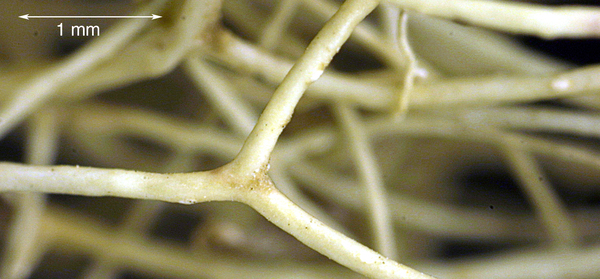
Felix Schumm - CC BY-SA 4.0
[9141], Spanien, Kanarische Inseln, La Gomera, Chorros de Epina, zwischen Arure und Vallehermoso. Im Lorbeer-Erica Wald, 28°09.830' N, 17°17.852 W, 750-850 m. Leg et det. F. Schumm 10.02.2002
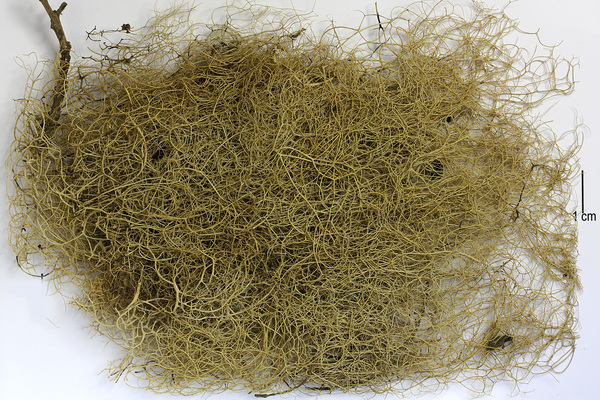
Felix Schumm - CC BY-SA 4.0
[9141], Spanien, Kanarische Inseln, La Gomera, Chorros de Epina, zwischen Arure und Vallehermoso. Im Lorbeer-Erica Wald, 28°09.830' N, 17°17.852 W, 750-850 m. Leg et det. F. Schumm 10.02.2002
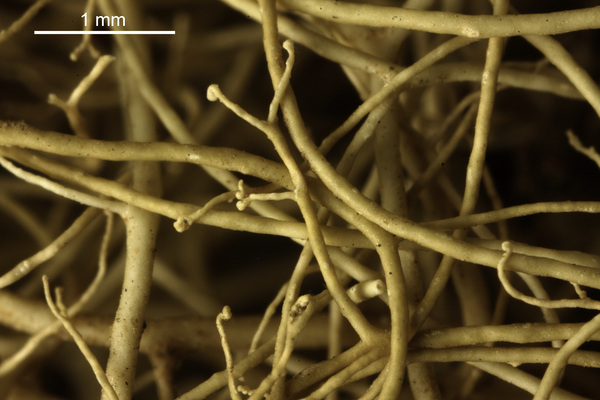
Felix Schumm - CC BY-SA 4.0
[9141], Spanien, Kanarische Inseln, La Gomera, Chorros de Epina, zwischen Arure und Vallehermoso. Im Lorbeer-Erica Wald, 28°09.830' N, 17°17.852 W, 750-850 m. Leg et det. F. Schumm 10.02.2002


Felix Schumm - CC BY 4.0
[2547], Südjugoslawien, Montenegro: vorhangbildend an halbhohen
und halbschattigen schütteren Nadelholzzweigen kaltluftstauender Lagen
im Evernietum divaricatae, 1500 m, NO-NW, pH 6.7, Crno Jezero
bei Zabljak im Durmitorgebirge. Leg. V. Wirth & A. V zda, 08.1976,
det. V. Wirth & A. V zda. Chemistry p193/7: divaricatic acid(!!). EX G.
FOLLMANN: LICHENES EXSICCATI SELECTI A MUSEO HISTORIAE NATURALIS
CASSELENSI EDITI NR. 218
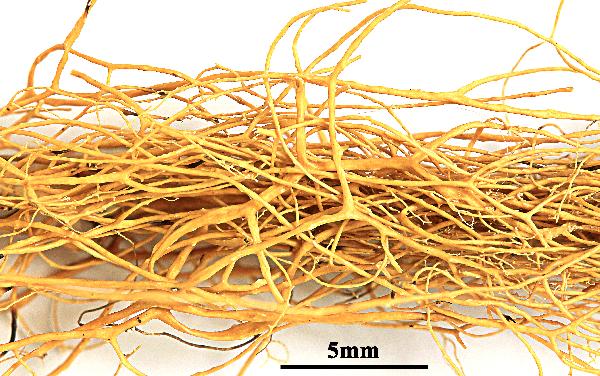

Felix Schumm - CC BY 4.0
[2547], Südjugoslawien, Montenegro: vorhangbildend an halbhohen
und halbschattigen schütteren Nadelholzzweigen kaltluftstauender Lagen
im Evernietum divaricatae, 1500 m, NO-NW, pH 6.7, Crno Jezero
bei Zabljak im Durmitorgebirge. Leg. V. Wirth & A. V zda, 08.1976,
det. V. Wirth & A. V zda. Chemistry p193/7: divaricatic acid(!!). EX G.
FOLLMANN: LICHENES EXSICCATI SELECTI A MUSEO HISTORIAE NATURALIS
CASSELENSI EDITI NR. 218
Growth form: Fruticose
Substrata: bark
Photobiont: green algae other than Trentepohlia
Reproductive strategy: mainly asexual, by soredia, or soredia-like structures (e.g. blastidia)
Most common in areas with a humid-warm climate (e.g. most of Tyrrenian Italy)
Commonnes-rarity: (info)
Alpine belt: absent
Subalpine belt: extremely rare
Oromediterranean belt: absent
Montane belt: very rare
Submediterranean belt: absent
Padanian area: absent
Humid submediterranean belt: absent
Humid mediterranean belt: absent
Dry mediterranean belt: absent

Predictive model
| Herbarium samples |


Felix Schumm – CC BY-SA 4.0
Image from: F. Schumm (2008) - Flechten Madeiras, der Kanaren und Azoren. Beck, OHG - ISBN: 978-3-00-023700-3


P.L. Nimis; Owner: Department of Life Sciences, University of Trieste
Herbarium: TSB (3692)
2001/12/07
hook-shaped soralium


P.L.Nimis; Owner: Department of Life Sciences, University of Trieste
Herbarium: TSB (36787)
2008.02.25

Felix Schumm - CC BY-SA 4.0
[9141], Spanien, Kanarische Inseln, La Gomera, Chorros de Epina, zwischen Arure und Vallehermoso. Im Lorbeer-Erica Wald, 28°09.830' N, 17°17.852 W, 750-850 m. Leg et det. F. Schumm 10.02.2002

Felix Schumm - CC BY-SA 4.0
[9141], Spanien, Kanarische Inseln, La Gomera, Chorros de Epina, zwischen Arure und Vallehermoso. Im Lorbeer-Erica Wald, 28°09.830' N, 17°17.852 W, 750-850 m. Leg et det. F. Schumm 10.02.2002

Felix Schumm - CC BY-SA 4.0
[9141], Spanien, Kanarische Inseln, La Gomera, Chorros de Epina, zwischen Arure und Vallehermoso. Im Lorbeer-Erica Wald, 28°09.830' N, 17°17.852 W, 750-850 m. Leg et det. F. Schumm 10.02.2002

Felix Schumm - CC BY-SA 4.0
[9141], Spanien, Kanarische Inseln, La Gomera, Chorros de Epina, zwischen Arure und Vallehermoso. Im Lorbeer-Erica Wald, 28°09.830' N, 17°17.852 W, 750-850 m. Leg et det. F. Schumm 10.02.2002

Felix Schumm - CC BY-SA 4.0
[9141], Spanien, Kanarische Inseln, La Gomera, Chorros de Epina, zwischen Arure und Vallehermoso. Im Lorbeer-Erica Wald, 28°09.830' N, 17°17.852 W, 750-850 m. Leg et det. F. Schumm 10.02.2002

Felix Schumm - CC BY-SA 4.0
[9141], Spanien, Kanarische Inseln, La Gomera, Chorros de Epina, zwischen Arure und Vallehermoso. Im Lorbeer-Erica Wald, 28°09.830' N, 17°17.852 W, 750-850 m. Leg et det. F. Schumm 10.02.2002

Felix Schumm - CC BY-SA 4.0
[9141], Spanien, Kanarische Inseln, La Gomera, Chorros de Epina, zwischen Arure und Vallehermoso. Im Lorbeer-Erica Wald, 28°09.830' N, 17°17.852 W, 750-850 m. Leg et det. F. Schumm 10.02.2002


Felix Schumm - CC BY 4.0
[2547], Südjugoslawien, Montenegro: vorhangbildend an halbhohen und halbschattigen schütteren Nadelholzzweigen kaltluftstauender Lagen im Evernietum divaricatae, 1500 m, NO-NW, pH 6.7, Crno Jezero bei Zabljak im Durmitorgebirge. Leg. V. Wirth & A. V zda, 08.1976, det. V. Wirth & A. V zda. Chemistry p193/7: divaricatic acid(!!). EX G. FOLLMANN: LICHENES EXSICCATI SELECTI A MUSEO HISTORIAE NATURALIS CASSELENSI EDITI NR. 218


 INDEX FUNGORUM
INDEX FUNGORUM
 GBIF
GBIF
 DOLICHENS
DOLICHENS
